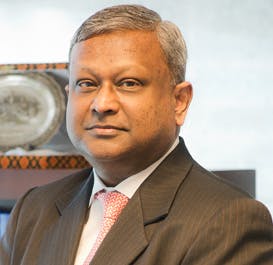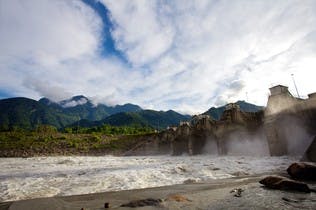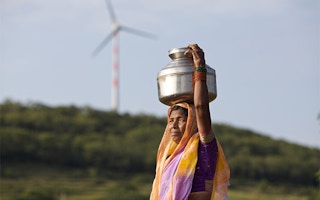Anthony J Jude is chair of the Asian Development Bank’s energy commitee and has more than 20 years of experience in various positions within ADB as director of units involving energy, transport and water.
To continue reading, subscribe to Eco‑Business.
There's something for everyone. We offer a range of subscription plans.
- Access our stories and receive our Insights Weekly newsletter with the free EB Member plan.
- Unlock unlimited access to our content and archive with EB Circle.
- Publish your content with EB Premium.
He leads ADB’s Asia Solar Energy Fund and works with the International Energy Agency (IEA) on regional energy training programs and policy formulation, and with the World Bank and the United Nations on sustainable energy.
As a speaker at the upcoming Singapore Energy Summit, he will share his view on low carbon development and green growth in the region. In this exclusive interview, he shares his insights with Eco-Business editor Jessica Cheam and outlines ADB’s role and approach in developing clean energy in Asia.
The summit, part of the Singapore International Energy Week, is a high-level dialogue convening ministers, policymakers and business leaders to discuss global energy trends and solutions needed for the energy sector. It features an interactive question and answer session where delegates can submit questions to speakers from their smart phones.
You will be speaking on low carbon development and green growth at the upcoming Singapore Energy Summit. Can you give us an overview of how Asia is faring in this area?

Anthony J Jude, chair of ADB’s energy committee, and practice leader (energy) in the Regional and Sustainable Development Department.
The answer to this is complex. In general, the outlook is positive, but more must be done to support acceleration of low-carbon development and green growth for Asia and the Pacific.
The region is on track to be a clean energy hub and has experienced uninterrupted growth in clean energy investment over the past nine years. In 2012, Asia became the leading regional destination for clean energy investment. The region attracted US$101 billion in clean energy, or around 42 per cent of the global total according to the Pew Charitable Trusts.
China is the dominant clean energy “power” in the region and the world. Other Asian countries that have attracted solid levels of clean energy investments include Japan, India, South Korea and Indonesia. However, China surpasses them all – in 2012 it attracted $65.1 billion in clean energy investments, 20 per cent more than in 2011, higher than any other country including the United States. Solar investment in China last year was $31.2 billion, wind investment was $27.2 billion. The remainder was invested in technologies such as small hydro and biomass.
The growth in Asia’s clean energy sector is supported by ADB’s own numbers. Last year, ADB invested $2.3 billion in clean energy. It had set a target to reach $2 billion of clean energy investments annually by 2013 and met the target two years ahead of schedule. It shows ADB’s continued commitment to a policy of supporting clean energy development in as many sectors and ways as possible.
This strategy, enshrined in ADB’s 2009 Energy Policy, correctly anticipated the high interest and enormous appetite for clean energy that exists among the developing countries of Asia and the Pacific.
Looking forward to 2035, ADB predicts that Asia’s use of renewable energy will increase by half over the coming decades, but all in all, renewables – not counting hydropower - will only account for 7 per cent of the power generation mix in 2035.
However, under circumstances where countries fully back renewables with the appropriate policies, enabling environments and incentives for private development, that percentage may reach 15.8 per cent by 2035. This is still small compared to the amount of energy that will be sourced from fossil fuels. Clearly, even under the best case scenario, more needs to be done to increase the rate of clean energy development and deployment.
In your opinion, what are some main challenges that Asia faces in accelerating a low-carbon, green economy?
“
Clean energy is disadvantaged at a fiscal and political level, facing off against a fossil-fuel based energy industry that is not only well established, but heavily supported in the form of financial subsidies and favorable national policy measures.
The main barriers to accelerating development towards green economies are in the fields of policy and finance.
National policy remains the most important market driver for clean energy, as shown through examples such as Thailand’s 15-year Renewable Energy Plan, the Indian National Solar Mission, feed-in-tariffs in the Philippines, and China’s ambitious energy intensity reduction and renewable energy development targets. In Indonesia, its feed-in tariffs is attracting over $1 billion in investments towards the development of its geothermal resources. These investments are the result of governments making clean energy and clean technology a policy priority. Where governments have created the frameworks to support and incentivize low-carbon development, private sector investment has followed.
Also, the high upfront costs of clean energy are well known, but another barrier that relates to both financing and policy would be the widespread subsidies for fossil fuels.
The existence of these subsidies prevents clean energy from competing on a level playing field. Clean energy is disadvantaged at a fiscal and political level, facing off against a fossil-fuel based energy industry that is not only well established, but heavily supported in the form of financial subsidies and favorable national policy measures.
The numbers are clear: according to IEA research, 37 governments spent $409 billion on subsidies to artificially lower the price of fossil fuels in 2010. In comparison, renewable energy technologies received subsidies worth $66 billion. These subsidies cover the spectrum: consumer subsidies, tax benefits, subsidies for exploration and production – but the five-fold difference is proof enough that clean energy is not competing on a level playing field.
What are some of the measures that the public and private sector should take to enable this?
“
In 2010, 37 governments spent $409 billion on subsidies to artificially lower the price of fossil fuels. In comparison, renewable energy technologies received subsidies worth $66 billion. The five-fold difference is proof enough that clean energy is not competing on a level playing field.
ADB is trying to step beyond simply providing financing to provide what we’ve termed “finance plus plus,” or financing for development, plus leveraging additional resources, knowledge, expertise and capacity building.
Developing Asian countries have a capacity issue – they lack expertise in the latest clean energy technologies. This is not only among the government, but even commercial banks in the region do not have the technical ability to evaluate an energy efficiency project on its merits.
ADB is ready to step in and help these institutions fill these gaps. To expand on my earlier point, ending fossil fuel subsidies would help level the playing field, and expose the true cost of current energy. However, despite the IMF finding that “80 per cent of the total benefits from petroleum subsidies in 2009 accrued to the richest 40 per cent of households, because the rich consume more energy than the poor,” ending these subsidies would have a strong, adverse effect on the most vulnerable households of society.
In one of our latest publications, ADB has stated that governments need to take a lead in changing the way the public perceives energy, encouraging smarter consumption and savings. Governments need to push the idea that energy is a scarce, valuable resource. By changing public perception, and pairing this with demand-side energy efficiency improvements – more efficient appliances for example, and conservation programs – widespread change can be affected.
“
Governments need to take a lead in changing the way the public perceives energy, encouraging smarter consumption and savings.
Are there some specific sectors that are leading in the region? What do you think has the biggest potential?
ADB’s approach to projects is to be technology agnostic, but we see great potential in solar, and have supported it through our Asia Solar Energy Initiative, which has helped bring more than 1 gigawatt of new solar generation online since it was launched in 2010. That said, there are extensive renewable energy resources, and equally extensive opportunities for increased energy efficiency throughout developing Asia and the Pacific region.
We’ve found that energy efficiency is often overlooked, but minimal investment can have huge returns. One of our latest studies on the subject has found that investments in energy efficiency equal to 1 to 4 per cent of overall energy sector spending can meet up to 25 per cent of the projected increase in primary energy consumption up to 2030. ADB aims to increase its support for demand-side energy efficiency going forward.
Sometimes the pursuit of sustainable, low carbon energy conflicts with the priority nations place on energy security. For instance, some countries are choosing to invest in extracting heavier fossil fuels because they are cheaper or easily available over cleaner, renewable sources - how can countries balance these two objectives?
The price of fossil fuels can be misleading because many of its costs are externalized – paid for by society and the environment rather than the project developer. For example, pollution is a cost that society pays for in coal-fired power plants. A second cost is rising energy insecurity. ADB’s figures predict that by 2035, most Asian countries will produce less than half the energy they need, and many will produce only a tiny fraction. This means that Asia will remain heavily dependent on energy imports, in particular of oil. That leaves entire national economies at the mercy of the often volatile international oil markets.
“
By 2035, most Asian countries will produce less than half the energy they need, and many will produce only a tiny fraction. This means that Asia will remain heavily dependent on energy imports, in particular of oil. That leaves entire national economies at the mercy of the often volatile international oil markets.
Developing Asia needs to diversify its power mix and look to regional integration of its energy supply and demands, and facilitate cross-border power trade.
Renewable energy has immense potential here, as renewable resources – solar, wind, geothermal – are found at varying levels across Asia. However, these resources are intermittent and cannot provide the base load generation needed. Nonetheless, countries could balance their energy needs through a mix of renewables (wind, solar and biomass) and coupled with hydropower to improve the clean energy mix.
Our outlook does show that coal will be a main part of Asia’s energy mix for the foreseeable future. In such a case, ADB can, if requested, help support countries to move towards adopting only the most modern and efficient coal-fired plants, supercritical plants that emit less carbon dioxide. This is far from an ideal situation, but it is one that we can help them adapt. For example, the current forecast for energy use shows that natural gas will grow alongside growth in coal use. Burning gas is “cleaner” than burning coal, so the imperative is to look at how to expand use of natural gas in a clean and safe way, and to look for ways to use coal in a more sustainable manner.
ADB develops clean energy projects in Asia by investing billions of dollars, but it has also been criticized for continuing to invest ‘dirty energy’ such as coal-fired projects. Can you shed some light on this? What guides ADB in its energy investment decisions?
ADB serves the developing Asian countries who are members of ADB. We are guided by their priorities and their decisions and this is agreed through our Country Partnership Strategy (CCPS), which is aligned with the country’s social economic development plan.

Solar and wind farms, hydropower and geothermal plants now power Asian cities with clean energy with the help of financing and capacity building from ADB. Source: ADB
Some countries do ask us to support fossil fuel development such as coal because the technology is time tested and well understood but also because they are not able to finance the generation expansion to meet domestic needs as well as to extend the grid for rural electrification.
Coal-based generation is still the cheapest source of energy for many of our member countries. The ADB’s 2009 Energy Policy, which is still relevant today states that we will support coal-based generation by our member countries if requested and we will encourage them to more up the technology level.
Since the policy approval, ADB has only approved two coal power plants and these were in line with our energy policy where we reached agreement with the countries to adopted higher technologies to reduce the CO2, and SOx and NOs emissions.
Having said this there are still a lot of coal power plants being built in Asean but these are all undertaken by the utilities with their own resources or through the private sector. ADB’s Energy Outlook and IEA’s recent energy outlook for Asean show that coal will continue to be a major primary source of energy and some developing countries will continue to develop coal fired power plants because of the energy security concerns and the availability of indigenous coal.
ADB may support coal fired power plants provided that they meet certain technical eligibility criteria and stringent ADB safeguard standards.
Finally, you are working with the UN and World Bank on the sustainable energy for all initiative - how is this progressing? Are the targets to improve the rate of energy efficiency and double the share of renewable energy realistically achievable by 2030?
“
Energy access is such a development game changer, it benefits so many facets of human development.
The main target is to achieve universal energy access by 2030, which will require investments of more than $40 billion a year until 2030. Despite this, the targets are achievable.
Energy access is such a development game changer, it benefits so many facets of human development, from creating economic opportunities and ensuring education, to enabling modern healthcare, Providing access to energy should be considered a prerequisite to fighting poverty. The absence of “modern energy access” in the Millennium Development Goal has been fixed, in a way, by the establishment of the Sustainable Energy for All campaign. ADB’s Energy Policy makes ensuring access to modern energy one of our main priorities in energy sector work.
We do believe that these three goals are realistically attainable with the correct policy framework in place and financial support. For example, just continuing current trends, new and renewable energy will increase its share in electricity generation in our region to 7.1 per cent in 2035, up from 1.9 per cent in 2010, meeting the Sustainable Energy for All goal for Asia. But why settle for that, when even higher levels of renewable power are attainable through the application of political will and multilateral backing?
To hear more from Anthony Jude and other speakers including the chief executive officer of Qatargas, Sheikh Khalid Bin Khalifa Al-Thani, who will deliver the keynote address, please register for the Singapore International Energy Week here.
Other panel discussions at the summit will cover topics such as the rising use of fossil fuels, evolving global energy dynamics, and Asia’s outlook and future energy needs. Key speakers on those panels include the Energy Ministers of Indonesia, Malaysia, and the state of Queensland in Australia.
This year, SIEW will also feature associated events such as the half-day Public Private Partnership (PPP) conference and seven roundtables, jointly hosted by renowned Singapore and international think-tanks.










